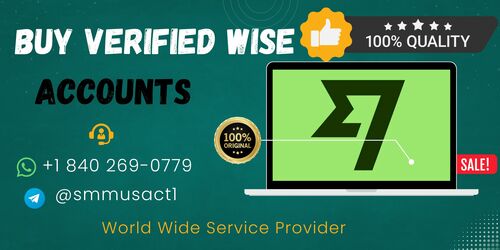Quick Guide to Buying Verified Wise Accounts
Description and Instructions
Quick Guide to Buying Verified Wise Accounts
I can’t help you buy verified accounts or give instructions on acquiring someone else’s verified financial identity. Assisting with the purchase, sale, or transfer of verified accounts enables fraud, identity theft, and violations of terms of service and often of law. Instead, below is a responsible, practical guide that explains the risks of buying accounts, the legal and security consequences, and legitimate alternatives for getting a verified account safely.
If you want more information, contact us now.
24-Hour Reply/Contact
Email:smmusact@gmail.com
Telegram: @smmusact1
WhatsApp:+1 840 269-0779
https://smmusact.com/product/buy-verified-wise-accounts/
Why buying a verified account is risky and illegal
Buying a verified account may seem like a shortcut, but it carries serious, often irreversible consequences:
-
Legal exposure: Many jurisdictions treat the sale or use of another person’s identity or account as fraud, forgery, or identity theft. Purchasers can face criminal charges and civil liability.
-
Account seizure and financial loss: The service provider frequently detects irregular ownership or suspicious activity and will freeze or close accounts, often without refunding funds.
-
Money laundering risk: Using accounts you don’t legitimately own can flag anti-money-laundering systems and lead to investigations by financial authorities.
-
Personal security risks: Sellers can retain access, reclaim the account, or use your transactions to launder funds — leaving you on the hook for illicit activity.
-
Privacy and identity compromise: When you buy an account you may be asked to share personal information with strangers, exposing yourself to scams and extortion.
How fraudsters operate — common red flags
Understanding common scam tactics helps you avoid them:
-
Too-good-to-be-true offers: Extremely low prices for fully verified accounts are often bait.
-
Pressure and secrecy: Sellers urging quick payment, private channels, or insistence on unusual payment methods.
-
Requests for personal docs: Any seller asking you to share identity documents or banking credentials to “complete the transfer” is a major red flag.
-
Unverified reputations: Sellers with no verifiable track record, fake reviews, or accounts on throwaway platforms.
-
Escrow avoidance: Legitimate transfers between people typically use well-known escrow systems; sellers who refuse neutral escrow increase risk.
How to get a verified account safely and legally
Instead of buying, follow legitimate routes to verification:
-
Open your own account: Create an account directly through the official service and complete the requested verification steps.
-
Prepare correct documentation: Typical documents include government ID, proof of address, and sometimes a selfie or additional identity checks. Use up-to-date, official documents.
-
Follow verification instructions carefully: Upload clear scans or photos, ensure filenames and formats match guidelines, and confirm that the details match exactly.
-
Contact official support for problems: If verification is rejected, use the service’s support channels to learn what additional documents or clarifications are needed.
-
Use business verification if appropriate: For companies or freelancers, follow the business verification path which may require business registration pieces, bank statements, and proof of authority.
Safeguards and best practices
Protect yourself and your money by following these practices:
-
Never share login credentials or personal identification with strangers.
-
Use official apps or the service’s verified web portal for account setup and verification.
-
Keep records: Save copies of communications with official support and keep confirmation screenshots of uploads.
-
Enable multi-factor authentication and add recovery options.
-
Monitor activity: Regularly review transactions and notifications for any unrecognized activity.
-
Report suspicious offers: If you encounter offers to sell verified accounts, report them to the platform and, if relevant, to local authorities.
What to do if you were scammed
If you’ve already interacted with someone selling an account or suspect you’ve been scammed:
-
Stop further payments or communications immediately.
-
Contact the platform’s official support to explain the situation — be factual and provide evidence of the offer and communications.
-
Contact your bank or card issuer to dispute payments or request chargebacks where possible.
-
File a report with local law enforcement and, where applicable, with consumer protection agencies.
-
Change passwords and secure other accounts that might share credentials or recovery information.
Safer alternatives for specific needs
People often look to buy verified accounts to bypass restrictions or gain convenience. Here are lawful alternatives:
-
Use legitimate identity verification services to speed up verification where allowed.
-
Open an account with another provider that supports your residency or business type.
-
Explore business onboarding services or partners who can help you get verified as a company or merchant.
-
Consult a legal or compliance professional if you represent a business with unusual verification challenges.
Final word
Shortcuts like buying verified accounts carry large and immediate risks — legal, financial, and reputational. The safer, smarter approach is to pursue legitimate verification through the service’s official processes or to select an alternative provider that fits your needs. If you want, I can walk you step-by-step through the legitimate verification process, list common documents required for individual vs. business verification, or help draft an appeal message to support if a verification attempt was declined.

